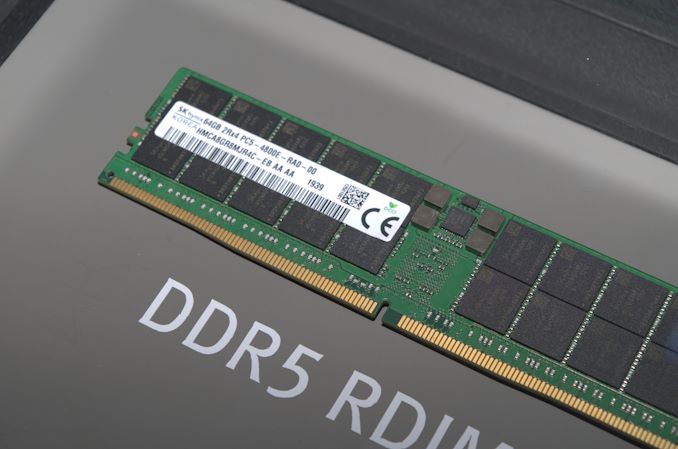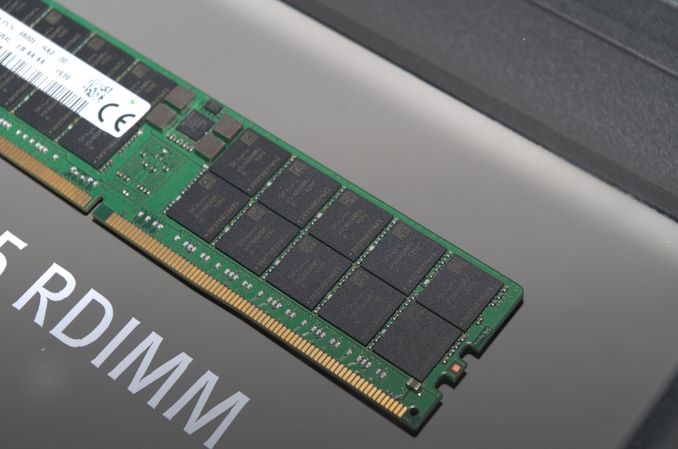Here's Some DDR5-4800: Hands-On First Look at Next Gen DRAM
by Anton Shilov on January 13, 2020 5:00 PM EST
Just like all major makers of DRAM, SK Hynix produced its first DDR5 memory chips a couple of years ago and has been experimenting with the technology since then. To that end, it is not surprising that the company displayed its DDR5 RDIMM at CES 2020, which implies that development is proceeding as planned.
At the trade show, SK Hynix demonstrated its 64 GB DDR5 RDIMM with ECC rated for a 4800 MT/sec/pin data transfer rate. The module marked as HMCA8GR8MJR4C-EB carries 20 memory chips marked as H5CNAG4NMJ as well as IDT’s P8900-Z2 register clock driver (RCD). The memory devices are marked differently than the ones SK Hynix used for 16 GB RDIMM back in late 2018, though we do not know the difference.
The DDR5 RDIMMS feature 288 pins on a slightly curved edge connector (to reduce the insertion force on every pin), just like DDR4 modules, yet its layout and design are a bit different when compared to DDR4 to prevent installment of DDR5 modules into DDR4 slots and vice versa.
It is unknown whether SK Hynix has already started to sample its DDR5 RDIMMs with developers of server platforms and servers, but it is obvious that all DRAM makers are aligning their DDR5 production schedules with CPU designers and other companies.
At present, it is unclear when exactly the first DDR5 platforms are set to hit the market, but a good guess would be 2021. One of the first platforms to confirm support for DDR5 memory has been Intel's Xeon Sapphire Rapids, set for deployment in the Aurora Supercomputer. AMD support for DDR5 is unknown so far.
Related Reading:
- CES 2020: Micron Begins to Sample DDR5 RDIMMs with Server Partners
- SK Hynix Details DDR5-6400
- SK Hynix Develops First 16 Gb DDR5-5200 Memory Chip, Demos DDR5 RDIMM
- Cadence & Micron DDR5 Update: 16 Gb Chips on Track for 2019
- Cadence and Micron Demo DDR5-4400 IMC and Memory, Due in 2019
- JEDEC: DDR5 to Double Bandwidth Over DDR4, NVDIMM-P Specification Due Next Year
Source: SK Hynix












38 Comments
View All Comments
JKflipflop98 - Friday, January 17, 2020 - link
I can assure you, EUV lithography is NOT "90% fiction".webdoctors - Monday, January 13, 2020 - link
Maybe not part of spec, but DDR4 modules are easily selling at 3200 MHz. If DDR5 isn't clocked much higher, seems sorta pointless to buy it, although these is good for server ECC spec'd stuff.Destoya - Monday, January 13, 2020 - link
It always seems sort of pointless at the beginning of memory generations but performance and cost significantly improve over time. DDR4 launched at 2400/2666 and was very expensive compared to DDR3; I paid over $300 for 16GB of 2666C16 when it was new on the market.Gastec - Saturday, February 8, 2020 - link
And you will pay even more for DDR5 modules for consumer desktop. Think of $500 for 32 GBAlexvrb - Monday, January 13, 2020 - link
...what? First of all, 3200 is absolutely part of spec. Second, you absolutely SHOULD compare spec to spec. Second, they're talking about 4266-6400 for JEDEC DDR5. That's a huge leap when you actually compare apples-to-apples, and I imagine we'll see non-spec modules MUCH faster. There are other improvements too.https://www.anandtech.com/show/11238/ddr5-to-doubl...
eek2121 - Monday, January 13, 2020 - link
It's a bigger step up than you realize: DDR5 DIMMs are actually dual channel (per module).antonkochubey - Tuesday, January 14, 2020 - link
Dual 32-bit channel, while DDR4 was single 64-bit channel. So total bus width is still the same, although random access to separate 'halves' of the module can be up to 2x faster in perfect conditions.Rudde - Tuesday, January 14, 2020 - link
Isn't it dual 40 bit channel?Mugur - Tuesday, January 14, 2020 - link
For ECC only.The_Assimilator - Tuesday, January 14, 2020 - link
This engineering sample module is literally clocked more than twice the speed of launch-day DDR4 which was at 2133 MT/s...